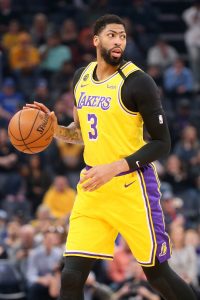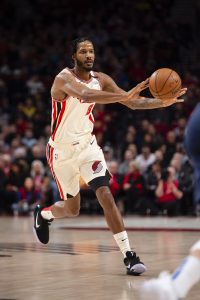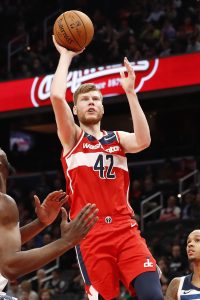A lot has changed since we published the second installment of our 2020 NBA free agent power rankings at the end of January. One player who showed up on that list (Dillon Brooks) has since signed a contract extension, taking himself off the 2020 market. More importantly though, the coronavirus pandemic has upended the NBA season and changed the landscape of the ’20 offseason.
In a normal year, most or all of the free agents on our last list would have come off the board by now, reaching contract agreements with new teams or their old clubs shortly after the negotiation period opened on June 30. Now though, the new league year has been pushed back to the fall — the 2020 free agent negotiating period won’t open until October 18.
Additionally, the stoppage forced by COVID-19 and the uncertainty surrounding the 2020/21 season will result in next season’s salary cap coming in lower than initially expected, and many teams around the NBA figure to tighten their purse strings when it comes to free agent spending. That means that the majority of the veterans who hold lucrative player options for ’20/21 are far more likely to simply exercise those options than to try their luck on the open market.
As a result, we’re taking many of the players that were on the last version of our FA power rankings off our list this time around. Andre Drummond, Gordon Hayward, DeMar DeRozan, Evan Fournier, and Tim Hardaway are among the players we’re now projecting to opt into the final year of their respective contracts rather than becoming free agents this fall.
As always, this list reflects each player’s current expected value on the 2020 free agent market, rather than a their present-day on-court contributions. For instance, an older player like Marc Gasol has strong short-term value, but didn’t crack our top 20 because he’s entering his age-36 season and is unlikely to sign a lucrative multiyear deal. In other words, age and long-term value are important.
If you need a refresher on which players will be free agents this fall, be sure to check out our FA lists sorted by position/type and by team.
With all that in mind, here’s the third installment of our 2020 free agent power rankings:
 Anthony Davis, F/C, Lakers (player option): Davis is the one player who remains a lock to turn down his option for 2020/21 — the cap would have to dip below $96MM for his $28.75MM option salary to be worth more than the 30% max he’d earn as a free agent. He also seems extremely likely to stick with the Lakers, given the team’s success this season, meaning the only mystery left is whether he’ll sign a short- or long-term deal.
Anthony Davis, F/C, Lakers (player option): Davis is the one player who remains a lock to turn down his option for 2020/21 — the cap would have to dip below $96MM for his $28.75MM option salary to be worth more than the 30% max he’d earn as a free agent. He also seems extremely likely to stick with the Lakers, given the team’s success this season, meaning the only mystery left is whether he’ll sign a short- or long-term deal.- Brandon Ingram, F, Pelicans (RFA): Besides Davis, Ingram is the best bet of any free agent this fall to sign a maximum-salary contract. Despite his looming payday, the Pelicans forward said he never considered sitting out the NBA’s restart this summer as his team prepares to push for the last playoff spot in the Western Conference.
- Fred VanVleet, G, Raptors: VanVleet has 76 career NBA starts under his belt, so his placement at No. 3 on this list is perhaps an indictment of the 2020 free agent class as a whole. Don’t sleep on his earning potential though. Rebuilding teams with cap room and a need at point guard – such as the Pistons or Knicks – may view the 26-year-old as an ideal long-term answer, given his abilities as a shooter, play-maker, and defender, which could force the Raptors into a bidding war.
- Montrezl Harrell, C, Clippers: Like VanVleet, Harrell is just 26 years old, meaning potential suitors can be pretty confident they’ll be getting his prime seasons even at the end of a four-year offer. Harrell’s per-36-minute production in his contract year (24.1 PPG, 9.2 RPG) has been better than ever, making him an intriguing long-term investment for a club in need of help up front.
- Bogdan Bogdanovic, G/F, Kings (RFA): The Kings’ trade-deadline moves, which included moving Dewayne Dedmon‘s pricey multiyear contract for a pair of expiring deals, suggest the team will prioritize locking up Bogdanovic to a new contract this fall. Bogdanovic made a strong impression in the weeks before the NBA season was suspended, moving into Sacramento’s starting lineup without his production missing a beat.
- Davis Bertans, F, Wizards: Unlike everyone else on this list, Bertans decided not to participate in the NBA’s restart this summer, citing his history of ACL injuries when he opted out. Still, the decision shouldn’t hurt Bertans’ value on the open market — his .424 3PT% on 8.7 three-point attempts per game make him one of the game’s most valuable stretch fours. The Wizards reportedly want to re-sign him, but they’ll likely face stiff competition.
- Malik Beasley, G, Timberwolves (RFA): No one saw his free agency value affected more significantly by a trade-deadline deal than Beasley, who went from an inconsistent bench piece in Denver to a full-time starter and key contributor in Minnesota. Beasley’s performance in 14 post-deadline contests (20.7 PPG and 5.1 RPG with a .426 3PT%) was a double-edged sword for the Timberwolves, who had to feel great about their decision to acquire Beasley and a little less great about his rising price tag.
- Danilo Gallinari, F, Thunder: Gallinari’s age (32 in August) and injury history work against his odds of securing a lucrative long-term deal, but he has been one of the NBA’s most reliable frontcourt scorers over the last couple years, averaging 19.5 PPG on .452/.421/.897 shooting since the start of the 2018/19 season.
- Joe Harris, G/F, Nets: Three-point shooting is more important than ever in the modern NBA and few players do it better than Harris, who has made 43.6% of his attempts from beyond the arc over the last three seasons.
- Serge Ibaka, F/C, Raptors: Ibaka, who turns 31 in September, isn’t the rim-protecting menace he was during his days with the Thunder, when he led the NBA in blocks in consecutive seasons. But he’s still a strong interior defender who can hold his own on switches and contributes on offense — his .398 3PT% in 2019/20 is a career high and will certainly appeal to potential suitors.
 Marcus Morris, F, Clippers: Morris was a little shaky in his first 12 games with the Clippers following a deadline deal — his scoring average was cut in half and his percentages dipped to 38.6% from the floor and 28.3% from three. Still, when taking into account the eye-popping numbers he was posting in New York, his full-season stats are strong, and he’s capable of defending offensive-minded forwards.
Marcus Morris, F, Clippers: Morris was a little shaky in his first 12 games with the Clippers following a deadline deal — his scoring average was cut in half and his percentages dipped to 38.6% from the floor and 28.3% from three. Still, when taking into account the eye-popping numbers he was posting in New York, his full-season stats are strong, and he’s capable of defending offensive-minded forwards.- Jerami Grant, F, Nuggets (player option): It took some time for Grant to adjust to his new team, but he showed in the two months leading up to the hiatus why the Nuggets were willing to surrender a first-round pick for him last summer. In his last 26 games, Grant averaged 14.0 PPG on .481/.420/.785 shooting, and the Nuggets were better with him on the court than off it.
- Christian Wood, F/C, Pistons: Wood played well through the season on a per-minute basis. However, he didn’t secure a spot on this list until he entered the starting lineup following the trade deadline and kept up his strong per-minute production while taking on a larger role. In his last 13 games, he posted 22.8 PPG, 9.9 RPG, 1.0 BPG, and a shooting line of .562/.400/.757. Now he’ll enter unrestricted free agency at age 25.
- Paul Millsap, F, Nuggets: I left Millsap off the first two iterations of our 2020 free agent power rankings due to the fact that he’ll turn 36 next February. But the more I see of him this season, the more I’m convinced he’ll still receive a nice payday on a two- or three-year deal this fall. His .440 3PT% is a career high and his impact on the Nuggets’ defense shouldn’t be overlooked. The club has a 102.2 defensive rating when Millsap plays, compared to 110.7 when he doesn’t.
- Hassan Whiteside, C, Trail Blazers: Whiteside’s impressive individual statistics don’t always translate to team success, but he deserves credit for the impact he’s had in Portland this season. His 3.1 blocks per game lead the NBA and his 14.2 rebounds per contest rank second. The Blazers have missed Jusuf Nurkic, but Whiteside has been as strong a replacement as the team could have realistically hoped for.
- Derrick Favors, C, Pelicans: The former third overall pick will never be an All-Star, but he’s still just 29 years old and has established himself as a reliable defender and rebounder (he’s averaging a career-best 9.9 RPG this season). While certain free agents get paid based on their potential ceiling, Favors’ value stems from his relatively high floor.
- Derrick Jones, F, Heat: Jones will reach unrestricted free agency at age 23, which is pretty uncommon for a rotation player on a top-four team in a conference. His numbers don’t jump off the page and his lack of a three-point shot will limit his value this fall. However, Jones is a tremendous athlete and a strong perimeter defender who still has room to improve.
- Tristan Thompson, C, Cavaliers: Thompson had one of his best seasons in 2019/20, averaging a double-double (12.0 PPG, 10.1 RPG) with a career-high in APG (2.1). He doesn’t necessarily have the versatility or shooting ability that teams would like to see from their bigs, but his skill set has value and he still has some prime years left.
- De’Anthony Melton, G, Grizzlies (RFA): It can be tricky to identify which second- or third-tier restricted free agent will do the best on the open market, since it only takes one suitor to drive up a player’s price. Fellow RFAs Jakob Poeltl and Dario Saric could certainly get better offers this fall than Melton, but I’m a big fan of the Grizzlies guard, an excellent perimeter defender whose +6.2 net rating this season is easily the best mark on the team.
- Aron Baynes, C, Suns: I was a little surprised that I ended up finding a spot on this list for Baynes, who will turn 34 this December and has never earned more than $6.5MM in a season. Perhaps I’m slightly overrating his strong season in Phoenix, but the big man showed an ability to score (11.5 PPG) and shoot (.351 3PT%) that he hadn’t before. Already a terrific screen-setter and strong defender, Baynes may be in line for the most lucrative contract of his career this fall. Marc Gasol, Dwight Howard, and Jordan Clarkson were among the other candidates for this last spot.
As I noted in the intro, there are some veterans who would earn a spot on this list – or would at least receive consideration – if they turn down player options and become free agents. At this point, I think they’re unlikely to do so, but not all of them are a lock to opt in. Here are some of the most notable names in that group with player options for 2020/21:
- Avery Bradley, G, Lakers ($5,005,350)
- Mike Conley, G, Jazz ($34,502,132)
- DeMar DeRozan, G, Spurs ($27,739,975)
- Andre Drummond, C, Cavaliers ($28,751,774)
- Evan Fournier, G/F, Magic ($17,150,000)
- Tim Hardaway Jr., G/F, Mavericks ($18,975,000)
- Gordon Hayward, F, Celtics ($34,187,085)
Disagree strongly with any of our rankings? Feel like we omitted any players that should be in the top 20? Weigh in below in the comments section to let us know!
Photos courtesy of USA Today Sports Images.



 In other words, players like
In other words, players like